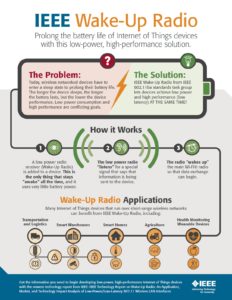The Internet of Things (IoT), the ability for devices in our everyday environment to connect and share information, offers amazing potential for positive impact in government, education, finance and transportation, as well as nearly endless consumer applications.
Companies are working to deploy billions of connected devices – from personal health and fitness trackers, to remote home monitoring and management systems, to community data sharing portals – that not only send alerts to your smartphone, but communicate with each other to maximize practicality and productivity. For example, imagine a fire alarm that doesn’t just beep, but shuts off your gas appliances and wakes you with an alert sent to your household phones.
However, as computing power increases, battery life becomes a problem, limiting IoT potential.
Eliminating the Limits

Extending battery life is a must for continued innovation. With the number of IoT devices projected to grow to more than 20 billion in just the next couple of years, energy conservation is critical. The trick lies in balancing power consumption with the performance of future networked devices exclusively dependent on battery power.
In order for IoT technology to flourish, especially in situations where it’s infeasible or impractical to frequently replace batteries (think pacemakers and other medical devices), a reduced need for frequent recharging or replacement of batteries is essential.
A low-power, low-latency solution will allow devices and sensors to last longer and become infinitely more useful.
Enter: Wake-Up Radio
 Wake-Up Radio removes the need to compromise between power savings and latency by reducing the significant energy waste that wireless devices cause during their idle communication mode. The radio consumes minute amounts of power while still being in a constant active or listening state. Wake-Up Radio goes into sleep mode with regular intervals in which it will wake up to sample the channel for activity.
Wake-Up Radio removes the need to compromise between power savings and latency by reducing the significant energy waste that wireless devices cause during their idle communication mode. The radio consumes minute amounts of power while still being in a constant active or listening state. Wake-Up Radio goes into sleep mode with regular intervals in which it will wake up to sample the channel for activity.
Incorporating the additional tiny radio, which runs over Wi-Fi and uses less power, allows the main battery to last significantly longer, by up to 694 days. According to Adrian Stephens, chair of the Wake-Up Radio standards task group, the technology “is suitable for a new class of battery-powered devices that will drive innovation and exciting new applications in the market.”
Get the Report
Academic researchers have worked on wake-up receivers for close to a decade. Now, with Wake-Up Radio, innovation in IoT devices is limitless.
To learn more about the specifics of how Wake-Up Radio works and some potential uses, check out the IEEE Technology Report on Wake-Up Radio, crafted to help stakeholders better understand the potential of the technology and market. This insightful report is available for purchase at a 50% discount for a limited-time only via IEEE Xplore.
Resources
(16 Nov 2017). IEEE Releases Report on Wake-Up Radio Technology Aimed at Increasing Battery Life for Wireless Devices. everything RF.
Brogan, Chris. (2 Apr 2018). Learn about IoT with IEEE. Making the Brand: Customer Experience with Chris Brogan.
Mackenzie, Craig. (1 March 2014). Internet of Things device battery life optimization: Engineering design considerations. Embedded Computing Design.
Sharma, Manoj. (October 2017). Wake-Up Radio Systems: A New Perspective. International Journal of Advanced Research in Computer Engineering & Technology.
Wilhelmsson, Leif and Sundman, Dennis. (18 Dec 2017). Wake-Up Radio – A key component of IoT? Ericsson Research Blog.
An Internet of Things. Postscapes.



No comments yet.